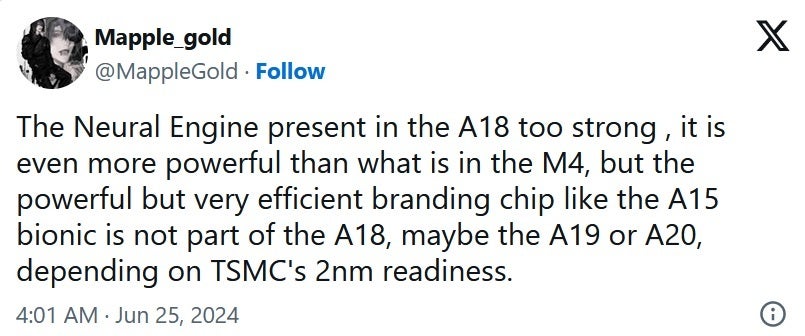Apple's A18 and A18 Pro APs will feature a more powerful Neural Engine than the one in the M4

Apple's M4 chip, currently powering the new 11-inch and 13-inch iPad Pro (2024) models, has a Neural Engine designed to handle AI-based features. The Neural Engine on the M4 operates at a speed of 38 trillion operations per second (TOPS) which tops the 35 TOPS that the A17 Pro's Neural Engine runs at. The A16 Bionic, found inside the iPhone 14 Pro, iPhone 14 Pro Max, the iPhone 15, and iPhone 15 Pro, has a Neural Engine capable of running 17 TOPS.
Despite the large discrepancy in the speed of the Neural Engine in the A17 Pro and the A16 Bionic, the reason why the iPhone 15 and iPhone 15 Plus won't be running Apple Intelligence while the iPhone 15 Pro and iPhone 15 Pro Max will has to do with the amount of DRAM on the different models. The non-Pro iPhone 15 units come with 6GB of DRAM while the Pro models are equipped with 8GB. And this year, all four iPhone 16 models will sport 8GB of DRAM allowing Apple Intelligence to work on all 2024 iPhones.
According to computer engineer and "X" subscriber @MappleGold (via Wccftech), who says that he is focused on semiconductors, the Neural Engine on the A18 is even more powerful than the Neural Engine on the M4. This is an indication that Apple Intelligence AI will be more capable with more features on the iPhone than on the iPad or even on Macs.

Tweet about the A18's Neural Engine posted by computer engineer MappleGold
There is also speculation that Apple is going to change the way it brands its application processors (APs) eliminating the terms "Powerful" and "More efficient." The change could take place this year with the introduction of the A18 and A18 Pro APs or Apple might wait until TSMC starts using its 2nm node to manufacture the A19 or A20 chips.
Regardless, Apple could increase the die size of its 2024 APs to accommodate a larger Neural Engine. While the iPhone 16 and iPhone 16 Plus are expected to be powered by the
A18, the iPhone 16 Pro, and iPhone 16 Pro Max are supposed to get the more capable A18 Pro. Both chips will be manufactured by TSMC using the foundry's second-generation 3nm process node (N3E). The first 3nm chipset used on an Apple device was the A17 Pro which powers the iPhone 15 Pro and iPhone 15 Pro Max. That chip is produced using TSMC's first-gen 3nm node (N3B). The M4 is built using the foundry's second-gen 3nm node.
A18, the iPhone 16 Pro, and iPhone 16 Pro Max are supposed to get the more capable A18 Pro. Both chips will be manufactured by TSMC using the foundry's second-generation 3nm process node (N3E). The first 3nm chipset used on an Apple device was the A17 Pro which powers the iPhone 15 Pro and iPhone 15 Pro Max. That chip is produced using TSMC's first-gen 3nm node (N3B). The M4 is built using the foundry's second-gen 3nm node.










Things that are NOT allowed: